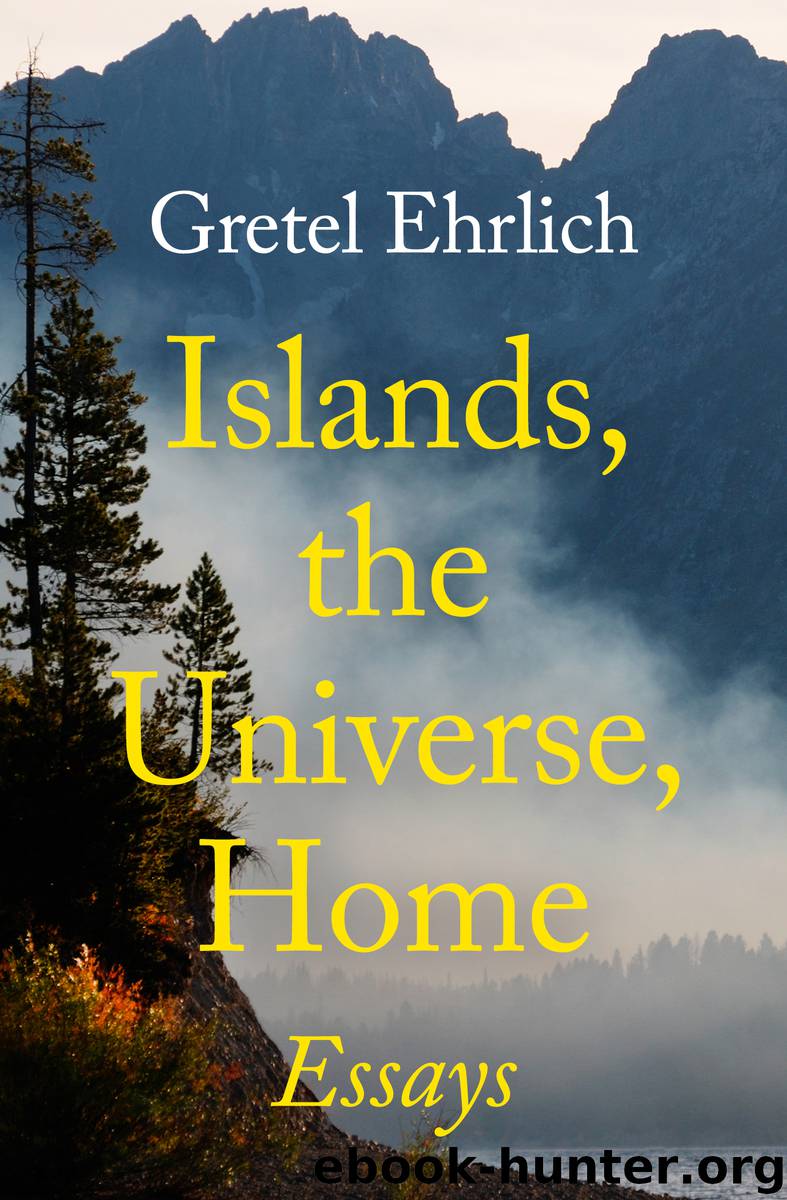Islands, the Universe, Home by Ehrlich Gretel;

Author:Ehrlich, Gretel;
Language: eng
Format: epub
Publisher: Open Road Media
Published: 2016-11-22T05:00:00+00:00
HOME IS HOW MANY PLACES
Wenè mu. That’s what the Chumash Indians called this southern California harbor: “resting place,” because it was here that they waited in their high-bowed, ocean-going canoes for rough seas to subside before they paddled to their island homes. My destination is Tuqan, the Chumash name for San Miguel, the northernmost of the Santa Barbara Channel Islands, about sixty miles from here.
In the dark, I step onto the Peace and stow my gear. She is a sixty-five-foot diesel-powered boat fitted out for diving expeditions, though tonight she is taking twenty of us on a museum-sponsored tour. Eleven P.M. rolls around. It is usual for the Chumash to wait until at least midnight before heading out, when the seas are calmer. James, the young, dark-haired captain, stumbles into the galley, rubbing sleep from his eyes. He asks for water and glances at the clock. “Not yet,” he says to no one in particular, then disappears up a ladder to his bunk because he’ll be on watch all night.
The harbor is quiet, only a gentle breeze. The decks have been scrubbed down, but the bolts that hold this iron workhorse together are rusted. By comparison, the Chumash tomol (canoe)—used as transportation between the mainland and the islands—was constructed from driftwood shaped into planks with rock tools and sanded smooth with cloths made from sharkskin. Lashed together with milkweed fiber and sealed with black asphaltum—the tar that seeped up on Santa Barbara beaches—the tomol was painted ocher, its bow inlaid with abalone shells that flashed in moonlight like two eyes.
For eight thousand years or more the Chumash lived in isolation and peace. One of at least sixty tribal groups in California, they once numbered fifteen thousand. They had no neighboring enemies and no warrior cult. Personal vengeance, carried out with poisonings, was the only violence they knew. Climate, the unjust taskmaster of the Plains nations, blessed the Chumash with year-round sun and abundant food from land and sea. Tule elk, deer, and bear were hunted; mussels and abalone were plucked from rocks; acorns, seeds, and berries were gathered. They lived in a five-thousand-square-mile paradise. From San Luis Obispo south to Malibu, the Chumash nation included a chain of pristine habitable islands, a unique south-facing coastal range, inland valleys, and three hundred miles of beach.
Hardly anything would be known about these people if it had not been for John Peabody Harrington, a Smithsonian anthropologist and onetime resident of Santa Barbara. In 1912 he returned to his hometown and rented a Spartan room in the ivy-covered Riviera Hotel. He was not a young man, having already amassed 800,000 pages of notes on Native American cultures elsewhere, but the Chumash were dear to his heart.
When he sat down with Fernando Librado, Maria Ignacio, and Mary Yee—Chumash descendants—to record every remembered detail of traditional and contemporary Chumash life, Fernando was already 108 years old.
“I remember Mr. Harrington,” Paulina, my friend, told me. She had grown up with Mary Yee’s daughter. “He wore an old suit, always the same one.
Download
This site does not store any files on its server. We only index and link to content provided by other sites. Please contact the content providers to delete copyright contents if any and email us, we'll remove relevant links or contents immediately.
The Lonely City by Olivia Laing(4565)
Animal Frequency by Melissa Alvarez(4148)
All Creatures Great and Small by James Herriot(3980)
Walking by Henry David Thoreau(3681)
Exit West by Mohsin Hamid(3632)
Origin Story: A Big History of Everything by David Christian(3470)
COSMOS by Carl Sagan(3346)
How to Read Water: Clues and Patterns from Puddles to the Sea (Natural Navigation) by Tristan Gooley(3236)
The Inner Life of Animals by Peter Wohlleben(3099)
How to Do Nothing by Jenny Odell(3099)
Hedgerow by John Wright(3095)
How to Read Nature by Tristan Gooley(3073)
Project Animal Farm: An Accidental Journey into the Secret World of Farming and the Truth About Our Food by Sonia Faruqi(3013)
Origin Story by David Christian(2990)
Water by Ian Miller(2950)
A Forest Journey by John Perlin(2909)
The Plant Messiah by Carlos Magdalena(2745)
A Wilder Time by William E. Glassley(2686)
Forests: A Very Short Introduction by Jaboury Ghazoul(2668)
